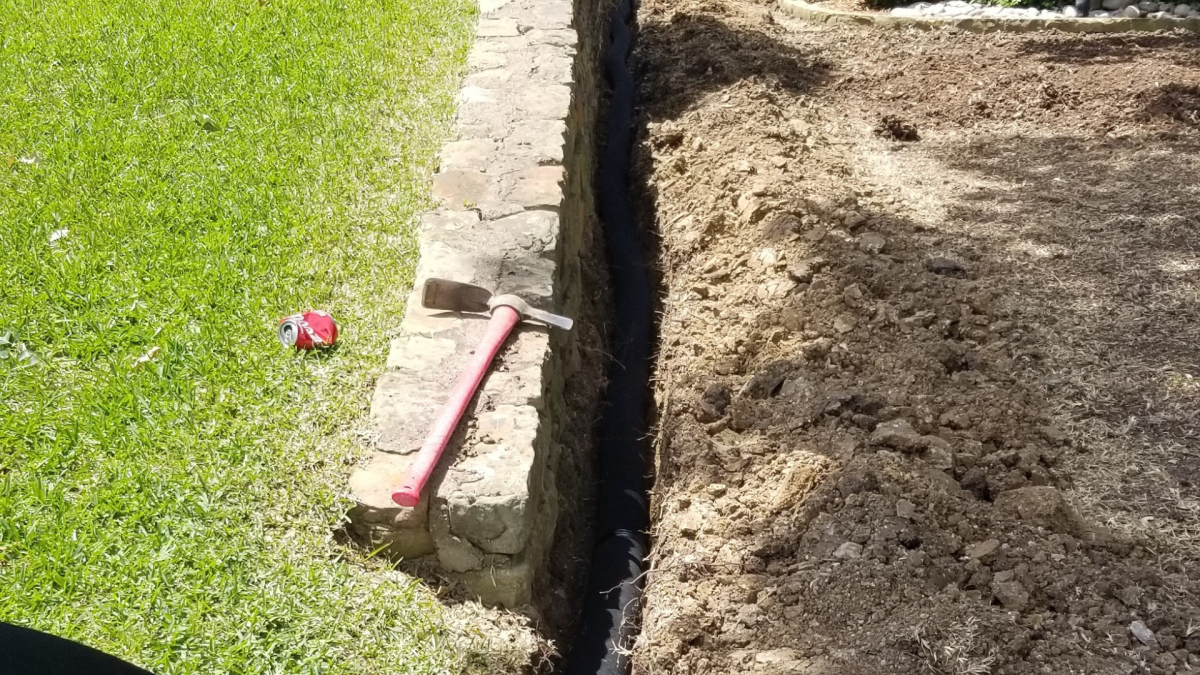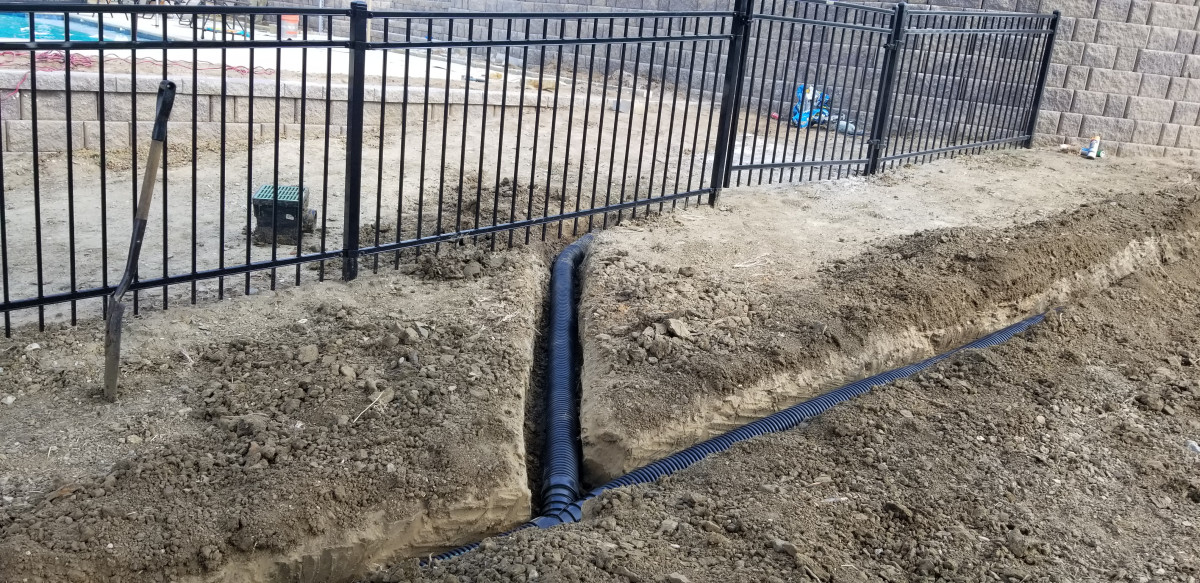Late fall weather patterns throughout Dallas, Highland Park, Coppell, and surrounding North Texas communities are exposing drainage problems that remained hidden during summer months. As rainfall increases and temperatures moderate, homeowners are discovering pooling water, erosion channels, and saturated landscape beds that signal serious grading and drainage deficiencies. Understanding proper drainage and grading solutions becomes essential as these issues threaten foundations, outdoor living spaces, and landscape investments.
The shift from summer's intense heat and occasional storms to fall's more consistent rainfall creates conditions that test every property's water management systems. Areas that appeared perfectly functional during dry periods now reveal their inadequacies, giving homeowners a critical window to address problems before winter compounds the damage.
The Real Cost of Ignoring Drainage Problems
Dallas area homeowners often underestimate the severity of drainage issues, viewing standing water as a temporary inconvenience rather than a warning sign of structural threats. The reality is far more serious. Poor drainage creates a cascade of problems that escalate in both scope and cost when left unaddressed.
Foundation damage represents the most expensive consequence of inadequate drainage. North Texas clay soils expand when saturated and contract during dry periods, creating tremendous pressure on foundation structures. When water pools near foundations or channels toward the home, it saturates soil unevenly, causing differential movement that cracks slabs and shifts pier and beam structures. The repairs for foundation damage often exceed tens of thousands of dollars, far surpassing the investment required for proper drainage solutions.
Landscape investments suffer significant damage from poor water management. Saturated soil suffocates plant roots, creating conditions for root rot and fungal diseases. Erosion washes away premium topsoil and expensive mulch applications, requiring constant replacement and creating unsightly channels through carefully designed beds. Hardscape features like patios, walkways, and retaining walls experience premature failure when water undermines their foundations or creates hydrostatic pressure behind retaining structures.
Outdoor living spaces become unusable when drainage problems persist. Patios collect standing water, walkways develop hazardous slippery conditions, and lawns turn into muddy quagmires that track into homes. The lifestyle impact extends beyond aesthetics, effectively eliminating outdoor areas from functional use during and after rainfall events.
Identifying Common Drainage Warning Signs
Late fall weather conditions make drainage deficiencies obvious to observant homeowners. Certain warning signs demand immediate attention, as they indicate problems that will worsen with continued rainfall and freeze-thaw cycles.
Standing water that persists more than 24 hours after rainfall indicates inadequate grading or compacted soil preventing proper percolation. Areas near foundations are particularly concerning, as prolonged saturation threatens structural integrity. Landscape beds that remain soggy indicate poor drainage that will eventually kill plants.
Erosion channels cutting through lawns, beds, or along hardscape edges show concentrated water flow overwhelming the landscape's capacity to manage runoff. These channels deepen with each rainfall event, eventually creating significant restoration challenges.
Basement or crawl space moisture signals serious grading problems directing water toward rather than away from the foundation. Even properties without full basements experience moisture intrusion that creates mold conditions and compromises air quality.
Settling or shifting hardscape including patios, walkways, or retaining walls indicates water undermining structural foundations. This damage accelerates once started, requiring increasingly extensive repairs as conditions deteriorate.
Dying plants in specific areas despite adequate care often indicates waterlogged soil suffocating roots. The pattern of plant decline typically follows drainage problem areas, making the connection clear once recognized.
Professional Solutions Address Root Causes
Effective drainage correction requires understanding water movement patterns and implementing solutions that address underlying causes rather than surface symptoms. Professional assessment identifies source issues and designs comprehensive corrections.
Regrading reshapes landscape contours to direct water away from structures and toward appropriate drainage points. This fundamental approach corrects the primary cause of most drainage problems. Proper grading maintains specific slopes that move water efficiently without creating erosion issues.
French drain installation captures and redirects subsurface water that grading alone cannot manage. These systems use perforated pipe surrounded by gravel to collect water and channel it to appropriate discharge points. Strategic placement addresses specific problem areas while working with overall property drainage patterns.
Surface drainage systems including channel drains, catch basins, and drainage swales manage concentrated runoff from roofs, driveways, and other impervious surfaces. These visible components work with subsurface systems to create comprehensive water management.
Soil amendment and aeration addresses compaction issues preventing water percolation. Clay soils common throughout the Dallas area benefit from amendments that improve drainage characteristics while maintaining adequate moisture retention for plant health.
Retaining wall construction manages elevation changes while incorporating proper drainage behind walls. Without adequate drainage provisions, hydrostatic pressure builds behind retaining structures, causing premature failure regardless of construction quality.
Experience with North Texas Soil and Climate Conditions
Beautiful Exteriors has developed extensive experience addressing drainage challenges specific to Dallas area properties since 2013. The company understands how North Texas clay soils behave under varying moisture conditions and designs solutions that account for these unique characteristics. Properties throughout Highland Park, Preston Hollow, Coppell, and Flower Mound present distinct drainage challenges based on original construction grading, soil composition variations, and existing landscape features.
Beautiful Exteriors approaches each property assessment without predetermined solutions, instead analyzing specific conditions to design appropriate corrections. This methodology ensures homeowners receive solutions calibrated to their property's actual needs rather than generic approaches that may not address underlying problems.
The company's technical knowledge extends beyond basic drainage principles to encompass how various solutions integrate with existing landscape features, hardscape elements, and architectural characteristics. This comprehensive understanding prevents solutions that fix drainage while creating new problems with other property elements.
Integrated Approach to Property Water Management
Effective drainage solutions consider the entire property as an integrated system. Water management begins at roof level, continues through collection and channeling systems, and concludes with appropriate discharge points that don't create problems for neighboring properties.
Professional French drain installation and comprehensive grading services evaluate how various property elements contribute to or exacerbate drainage problems. Downspouts, driveway runoff, landscape irrigation, and natural terrain all factor into comprehensive solutions. Addressing one element while ignoring others creates incomplete corrections that fail under challenging weather conditions.
Beautiful Exteriors designs drainage solutions that remain visually appropriate for upscale properties. Homeowners throughout affluent Dallas neighborhoods expect functional corrections that don't compromise aesthetic qualities. Strategic placement, quality materials, and thoughtful integration ensure drainage systems enhance rather than detract from property appearance.
Late Fall Timing Provides Optimal Correction Window
Late fall weather provides ideal conditions for drainage correction work. Soil moisture levels allow excavation without the difficulties of summer's concrete-hard clay or spring's muddy conditions. Moderate temperatures make installation work more efficient, and completion before winter ensures new systems are tested during remaining fall rainfall.
Addressing drainage problems before winter prevents freeze-thaw damage to already compromised areas. Water trapped in erosion channels or pooling areas expands when frozen, accelerating deterioration of surrounding landscape features and hardscape elements. Properties entering winter with unresolved drainage issues face significantly worse conditions by spring.
Taking Action on Visible Warning Signs
Fall rainfall has made drainage deficiencies impossible to ignore across Dallas area properties. What appears as standing water or minor erosion today becomes foundation cracks, dead landscape beds, and failed hardscape tomorrow. The current season provides both clear visibility of problems and favorable conditions for corrections.
Homeowners throughout Coppell, Highland Park, Preston Hollow, Flower Mound, and surrounding Dallas communities noticing drainage issues can reach Beautiful Exteriors at 469-945-7742 for property assessment. Beautiful Exteriors has addressed drainage challenges across North Texas since 2013, developing solutions specific to local clay soils and weather patterns.




